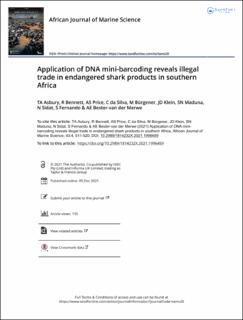| dc.contributor.author | Asbury, Tamaryn A. | |
| dc.contributor.author | Bennett, Rhett | |
| dc.contributor.author | Price, Aidan | |
| dc.contributor.author | da Silva, Charlene | |
| dc.contributor.author | Bürgener, Markus | |
| dc.contributor.author | Klein, Juliana D. | |
| dc.contributor.author | Maduna, Simo | |
| dc.contributor.author | Sidat, N. | |
| dc.contributor.author | Fernando, S. | |
| dc.contributor.author | Bester-van der Merwe, Aletta E. | |
| dc.date.accessioned | 2022-02-02T09:25:31Z | |
| dc.date.available | 2022-02-02T09:25:31Z | |
| dc.date.created | 2021-12-06T18:32:00Z | |
| dc.date.issued | 2021-12-05 | |
| dc.identifier.citation | African Journal of Marine Science. 2021, 43 (4), 511-520. | en_US |
| dc.identifier.issn | 1814-232X | |
| dc.identifier.uri | https://hdl.handle.net/11250/2976591 | |
| dc.description.abstract | In recent decades, a combination of increasing demand and economic globalisation has created a global market for elasmobranch products, especially the highly prized shark fins for Asian markets. Morphological species identification, as well as traditional cytochrome c oxidase subunit I (COI) barcoding of shark fins and other products, become challenging when in a processed state (such as dried or bleached shark fins). Here a mini-barcoding multiplex assay was applied to determine the species of origin in case studies from southern Africa involving confiscated shark fins in different states of processing. This highlights that the illegal shark fin trade in southern Africa to a large extent comprises threatened species. Matching of sequences of the confiscated fins against public databases revealed several threatened species, including the CITES-listed species Carcharodon carcharias, Carcharhinus longimanus, Isurus oxyrinchus, Rhynchobatus djiddensis and Sphyrna lewini. The findings highlight the need for improved trade monitoring, such as to eliminate illegal trade in shark fins, which can in part be achieved through more widespread genetic sampling of internationally traded products. However, a major limitation to DNA barcoding in general lies in the lack of curated voucher specimens available on public databases. To facilitate the application of molecular methods in a more comprehensive evaluation of elasmobranch trade regionally, a concerted effort to create reliable curated sequence data is recommended. | en_US |
| dc.language.iso | eng | en_US |
| dc.publisher | Informa UK Limited, trading as Taylor & Francis Group | en_US |
| dc.rights | Navngivelse 4.0 Internasjonal | * |
| dc.rights.uri | http://creativecommons.org/licenses/by/4.0/deed.no | * |
| dc.title | Application of DNA mini-barcoding reveals illegal trade in endangered shark products in southern Africa | en_US |
| dc.type | Peer reviewed | en_US |
| dc.type | Journal article | en_US |
| dc.description.version | publishedVersion | en_US |
| dc.rights.holder | © 2021 The Author(s) | en_US |
| dc.subject.nsi | VDP::Genetikk og genomikk: 474 | en_US |
| dc.subject.nsi | VDP::Genetics and genomics: 474 | en_US |
| dc.source.pagenumber | 511-520 | en_US |
| dc.source.volume | 43 | en_US |
| dc.source.journal | African Journal of Marine Science | en_US |
| dc.source.issue | 4 | en_US |
| dc.identifier.doi | 10.2989/1814232X.2021.1996459 | |
| dc.identifier.cristin | 1965275 | |
| cristin.ispublished | true | |
| cristin.fulltext | original | |
| cristin.qualitycode | 1 | |

